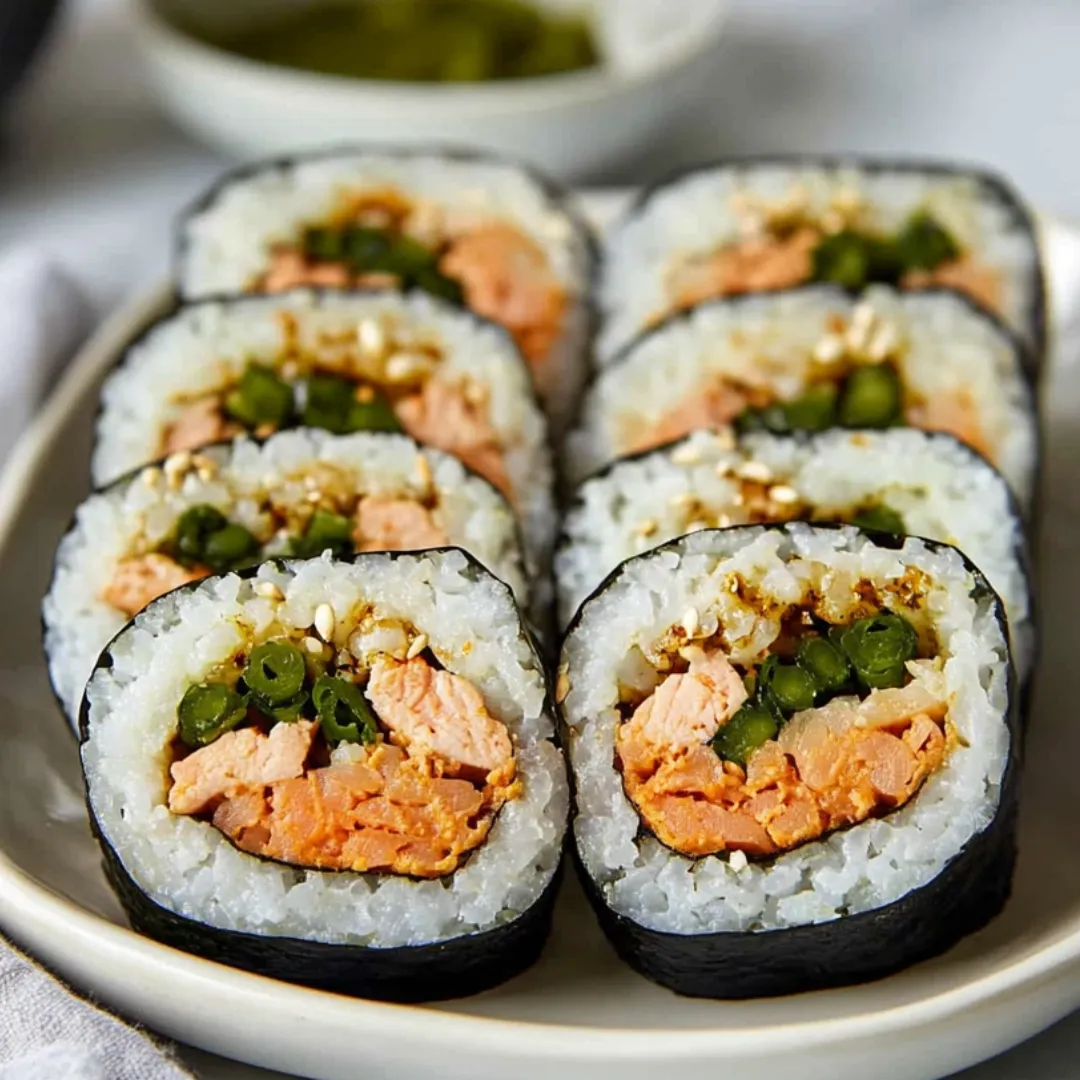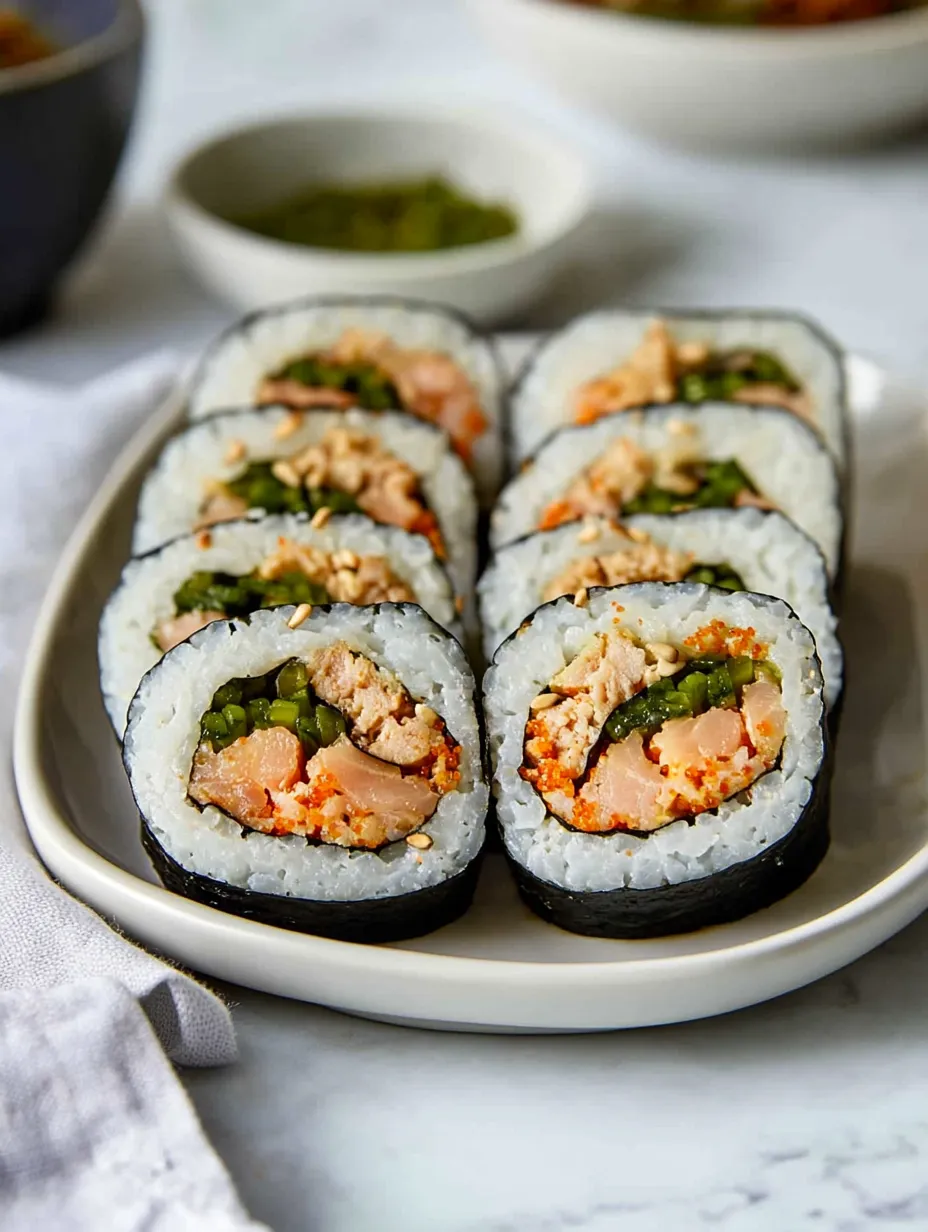 Save Pin
Save Pin
This filling spicy tuna kimbap has been my favorite go-to when I need something fast that's still packed with taste. I love how the well-seasoned rice, flavorful tuna, and fragrant perilla leaves work together to create a wonderful mix of textures and flavors that always hits the spot.
I came up with this dish during a super busy week when I wanted something quick but tasty. At first my family wasn't sure about trying homemade kimbap, but now we grab these for last-minute outdoor meals and car trips all the time.
Ingredients
- Nori sheets: grab new packs for the crispiest texture and best taste when wrapping
- Perilla leaves: these add an amazing mint-like flavor that makes the kimbap stand out, though you can use lettuce if needed
- Short grain rice: you can't skip this as it gives you that sticky texture that keeps everything in place
- Canned tuna: oil-packed brings more taste but you can use water-packed for something lighter
- Japanese mayo: try to get Kewpie for that special rich flavor that normal mayo just doesn't have
- Sriracha sauce: lets you control the heat while adding nice garlicky notes
- Sesame oil: go for the toasted kind to get that nutty smell that's key in Korean food
- Sesame seeds: gives a nice little crunch and makes the rolls look prettier
Step-by-Step Instructions
- Fix up the tuna mix:
- Drain your canned tuna really well using a strainer and push down with a fork to get all the extra liquid out. This keeps your kimbap from getting mushy. Mix it with chopped green onions, Japanese mayo, and sriracha in a bowl until it's well combined but still a bit chunky. You want it to stick together but not turn into paste.
- Fix up the rice:
- Use rice that's still hot for the best results. The heat helps mix in the sesame oil, seeds, and salt through all the grains. After you mix it, cover with a damp cloth to keep it sticky and moist, which you need for good rolling.
- Get ready to roll:
- Put your nori sheet rough side up on a clean board or bamboo mat if you have one. The rough side helps the rice stick better while rolling. Keep your hands slightly wet so rice won't stick to them when you spread it.
- Put down the rice:
- Scoop one cup of your seasoned rice onto the middle of the nori and push it outward with gentle pressure, leaving an inch empty at the top. Make sure the rice layer is even but don't push too hard or your kimbap will end up too dense.
- Add your fillings:
- Lay perilla leaves overlapping down the middle of the rice to make a barrier for the spicy tuna. Shape your tuna mix into a log about an inch thick right on top of the leaves. Don't try to spread it too thin or it'll squeeze out when you roll it.
- Roll it up:
- Start rolling from the bottom edge closest to you, keeping steady pressure the whole time. Use your fingertips to tuck in the filling as you go to keep a tight cylinder shape. Let the roll sit on the final edge for a moment so the warm rice can seal it shut.
- Add final touches:
- Lightly brush the outside of your roll with sesame oil for extra flavor and a nice shine. This also keeps the nori from getting too tough and helps the sesame seeds stick when you sprinkle them on top.
- Cut it nicely:
- Put a little oil on your knife before cutting to stop it from sticking. Hold the roll firmly but gently and use a back-and-forth motion to make clean slices about an inch thick. Wipe and oil your knife between cuts for the prettiest results.
 Save Pin
Save Pin
The perilla leaves are really what makes this dish special. I found out how important they are during a trip to South Korea when a local grandma told me they're absolutely needed for real kimbap. They taste kind of like mint mixed with basil plus a hint of licorice that goes amazingly well with the spicy tuna.
Storage Guidelines
Nothing beats freshly made kimbap right after you've prepared it when the seaweed is still nice and crisp. But if you need to make it ahead, wrap each roll tightly in plastic wrap before putting it in the fridge. This keeps moisture out that would make the seaweed go soft. Try to eat your refrigerated kimbap within a day and let it warm up to room temperature before eating for the best taste and texture.
Clever Substitutions
You can easily switch things up in this recipe based on what you've got at home. Can't find perilla leaves? Try baby spinach or butter lettuce instead to wrap around the filling. Don't want tuna? Go for canned salmon or leftover shredded chicken mixed with the same sauce. Want a vegetarian option? Switch the tuna for diced tofu or tempeh soaked in some soy sauce, sesame oil, and sriracha. No Japanese mayo? Mix regular mayonnaise with a bit of rice vinegar and sugar as a pretty good stand-in.
 Save Pin
Save Pin
Serving Suggestions
Most folks eat kimbap with kimchi for a tangy crunch on the side, but there are lots of other things that go great with it. Try serving with a small bowl of miso soup for a light full meal. When making appetizers, put the slices on a pretty plate with a small dish of soy sauce mixed with wasabi for dipping. For picnics or travel, wrap each piece in parchment or plastic for easy snacking. For family dinners, make several kinds with different fillings and put them all on a big platter so everyone can try a bit of everything.
Cultural Context
Kimbap holds a special spot in Korean food as both everyday food and something for special occasions. Unlike Japanese sushi that often has raw fish, Korean kimbap usually uses cooked stuff, making it safer for lunch boxes and outdoor eating. People started loving it in the mid-1900s as an easy portable meal for workers and students. The name puts together "kim" (seaweed) and "bap" (rice) showing its main parts. In Korean homes, making kimbap is often a family activity where everyone helps out in the process, creating good memories along with tasty food.
Common Recipe Questions
- → What type of tuna should I use?
Any canned tuna works fine for this dish. Just make sure you drain it well before mixing.
- → Can I substitute perilla leaves?
Don't worry if you can't find perilla leaves - try using green leaf lettuce or spinach instead.
- → How can I adjust the spice level?
Add more or less sriracha based on how hot you like things, or try gochujang for an authentic Korean flavor.
- → How do I prevent the rolls from falling apart?
Spread your rice and tuna mix evenly, then roll firmly but gently so the filling stays put.
- → What's the best way to slice kimbap cleanly?
Grab a sharp knife, wipe it with some sesame oil, and you'll get clean cuts without the rice sticking.
